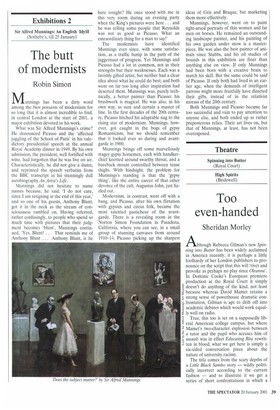Sir Alfred Munnings: An English Idyll (Sotheby's, till 25 January)
The butt of modernists
Robin Simon
Munnings has been a dirty word among the bien pensants of modernism for so long that it is almost incredible to find, in central London at the start of 2001, a major exhibition devoted to his work.
What was Sir Alfred Munnings's crime? He denounced Picasso and the 'affected juggling of the School of Paris' in his valedictory presidential speech at the annual Royal Academy dinner in 1949. By his own admission, the president, well fortified with wine, had forgotten that he was live on air. Characteristically, he did not give a damn, and reprinted the speech verbatim from the BBC transcript in his stunningly dull autobiography An Artist's Life.
Munnings did not hesitate to name names because, he said, 'I do not care, since I am resigning at the end of this year,' and so one of his guests, Anthony Blunt, got it in the neck as the stream of consciousness rambled on. Having referred, rather confusingly, to people who spend so much time with pictures that their judgment becomes 'blunt', Munnings continued, 'Yes, Blunt! ... That reminds me of Anthony Blunt . . . Anthony Blunt, is he here tonight? He once stood with me in this very room during an evening party when the King's pictures were here. . . and he was telling some people that Reynolds was not as good as Picasso. What an extraordinary thing for a man to say!'
The modernists have identified Munnings ever since, with some satisfaction, as a traffic hump in the path of the juggernaut of progress. Yet Munnings and Picasso had a lot in common, not in their strengths but their weaknesses. Each was a lavishly gifted artist, but neither had a clear idea about what he could do best; and both went on far too long after inspiration had deserted them. Munnings was, purely technically, a better painter than Picasso: his brushwork is magical. He was also, in his own way, as sure and certain a master of line. In the first decades of the 20th century, Picasso hitched his adaptable nag to the rising star of modernism. Munnings, however, got caught in the bogs of gypsy Romanticism, but we should remember that it looked ever so daring and avantgarde in 1900.
Munnings brings off some marvellously stagey gypsy horsemen, each with handkerchief knotted around swarthy throat, and a bareback mount controlled between tense thighs. With hindsight, the problem for Munnings's standing is that the 'gypsy thing', like the entire career of that other devotee of the cult, Augustus John, just fizzled out.
Modernism, in contrast, went off with a bang, and Picasso, after his own flirtation with gypsies and circus folk, became the most talented pasticheur of the avantgarde. There is a revealing room in the Norton Simon Foundation in Pasadena, California, where you can see, in a small group of stunning canvases from around 1910-14, Picasso picking up the sharpest ideas of Gris and Braque, but marketing them more effectively.
Munnings, however, went on to paint tight-arsed portraits of thin women and fat men on horses. He remained an outstanding landscape painter, and his painting of his own garden under snow is a masterpiece. He was also the best painter of animals since Stubbs, and his oil studies of hounds in this exhibition are finer than anything else on view. If only Munnings had been born with a creative brain to match his skill. But the same could be said of Picasso. If only both had lived in an earlier age, when the demands of intelligent patrons might more fruitfully have directed their gifts, instead of in the relativist morass of the 20th century.
Both Munnings and Picasso became far too successful and vain to pay attention to anyone else, and both ended up as rather preposterous relics. Their art lives on, but that of Munnings, at least, has not been overexposed.






























































 Previous page
Previous page